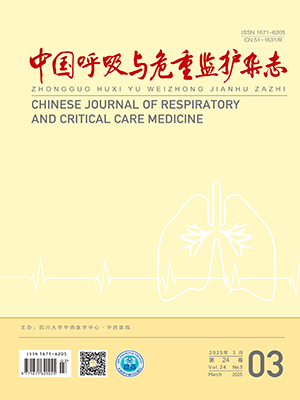Objective To investigate whether the new oxygenation index [ PaO2 /( FiO2 ×Paw ) ]which including mean airway pressure ( Paw ) for assessing intrapulmonary shunting of acute respiratory distress syndrome( ARDS) could be more accurate than the conventional oxygenation ratio ( PaO2 /FiO2 ) .Methods Twelve patients with ARDS were recruited. All patients received mechanical ventilation under lung ventilation protective strategy ( VT 6 mL/kg, f 16 bpm, FiO2 60% ) , and had a Swan-Ganz catheter inserted. Then, pressure/ volume curves were determined by low-flow method and the lower inflection point pressure was surveyed. Subsequently, parameters of respiratory mechanics and haemodynamics were recorded while periphery and pulmonary artery blood gas analysis were performed when positive end expiratory pressure ( PEEP) were changed. PaO2 /FiO2 and Qsp/Qt were calculated through special formula respectively. Results The progressive PEEP could not change Cst, PaO2 /FiO2 , and PaO2 / ( FiO2 ×Paw) in patients with ARDS significantly ( P gt; 0. 05) . The progressive PEEP did not change Qsp/Qt significantly ( P gt;0. 05) . The Δz which was used to test the difference between the correlation coefficient of Qsp/Qt and PaO2 / ( FiO2 ×Paw) and the correlation coefficient of Qsp/Qt and PaO2 /FiO2 was 0. 571, and there was no difference between the two correlation coefficients ( P gt; 0. 05) . It was not Paw but Cst which impacted on Qsp/Qt and PaO2 /FiO2 . Conclusion PaO2 / ( FiO2 × Paw ) is equal to PaO2 /FiO2 in assessing intrapulmonary shunting of ARDS.
Citation:
LIU Changwen,HU Weihang,HU Wei,LU Jun,ZHENG Yongke,ZHU Keyi,ZHU Ying,WANG Jianrong.. The Value of PaO2 /( FiO2 ×Paw ) in Assessing Intrapulmonary Shunting in Acute Respiratory Distress Syndrome. Chinese Journal of Respiratory and Critical Care Medicine, 2010, 9(6): 560-563. doi:
Copy
Copyright © the editorial department of Chinese Journal of Respiratory and Critical Care Medicine of West China Medical Publisher. All rights reserved
| 1. |
陈成, 黄建安. 急性肺损伤/ 急性呼吸窘迫综合征预后评估指标研究进展. 中国呼吸与危重监护杂志, 2008, 7 : 156-160.
|
| 2. |
Mohamad FE, Ghassan WJ. A new oxygenation index for reflecting intrapulmonary shunting in patients undergoing open-heart surgery.Chest, 2004, 125: 592 -596.
|
| 3. |
中华医学会重症医学分会. 急性肺损伤/急性呼吸窘迫综合征诊断和治疗指南( 2006 ) . 中华急诊医学杂志, 2007, 12 : 343 -349.
|
| 4. |
Meaghan M, Taylor RN, CRNP/ ACNP. ARDS Diagnosis and Management. Dimens Crit Care Nurs, 2005, 24: 197 -207.
|
| 5. |
Nirmalan M, Willard T, Columb MO, et al. Effect of changes in arterial-mixed venous oxygen content difference [ C( a-v) O2 ] on indices of pulmonary oxygen transfer in a model ARDS lung. Br J Anaesth, 2001, 86: 477 -485.
|
| 6. |
Hedwig M,Maurice L, Ginette D, et al. An animal modelof response and nonresponse to inhaled nitric oxide in endotoxin-induced lung injury. Chest, 2001, 120: 573-581.
|
| 7. |
Nunn JF. Applied respiratory physiology. 4 th ed. O ×ford UK:Butterworth-Heinemann, 1993.
|
| 8. |
邱海波. Swan-Ganz 肺动脉导管不应在重症加强治疗病房中常规应用. 中华外科杂志, 2006, 44 : 1222 -1224 .
|
| 9. |
Scott HD, Willia DB, Kirby LZ, et al. Pulmonary-artery versus central venous catheter to guide treatment of acute lung injury. N Engl J Med, 2006 , 354: 2213-2224.
|
| 10. |
Gowda MS, Klocke RA. Variability of indices of hypoxemia in adult respiratory distress syndrome. Crit Care Med, 1997, 25 : 41 -45.
|
| 11. |
Villar J, Perez-Mendez L, Kacmarek RM. Current definitions of acute lung injury and the acute respiratory distress syndrome do not reflect their true severity and outcome. Intensive Care Med, 1999 , 25 : 930 -935.
|
| 12. |
侯静静, 朱蕾, 钮善福, 等. 氧合指数的影响因素及其在急性肺损伤诊断中的作用. 中华急诊医学杂志, 2006 , 11: 971-974.
|
| 13. |
李志强, 朱波, 王长友, 等. 高呼气末正压机械通气策略在ARDS患者中应用的系统评价. 中国呼吸与危重监护杂志, 2009, 8 :279-283.
|
- 1. 陈成, 黄建安. 急性肺损伤/ 急性呼吸窘迫综合征预后评估指标研究进展. 中国呼吸与危重监护杂志, 2008, 7 : 156-160.
- 2. Mohamad FE, Ghassan WJ. A new oxygenation index for reflecting intrapulmonary shunting in patients undergoing open-heart surgery.Chest, 2004, 125: 592 -596.
- 3. 中华医学会重症医学分会. 急性肺损伤/急性呼吸窘迫综合征诊断和治疗指南( 2006 ) . 中华急诊医学杂志, 2007, 12 : 343 -349.
- 4. Meaghan M, Taylor RN, CRNP/ ACNP. ARDS Diagnosis and Management. Dimens Crit Care Nurs, 2005, 24: 197 -207.
- 5. Nirmalan M, Willard T, Columb MO, et al. Effect of changes in arterial-mixed venous oxygen content difference [ C( a-v) O2 ] on indices of pulmonary oxygen transfer in a model ARDS lung. Br J Anaesth, 2001, 86: 477 -485.
- 6. Hedwig M,Maurice L, Ginette D, et al. An animal modelof response and nonresponse to inhaled nitric oxide in endotoxin-induced lung injury. Chest, 2001, 120: 573-581.
- 7. Nunn JF. Applied respiratory physiology. 4 th ed. O ×ford UK:Butterworth-Heinemann, 1993.
- 8. 邱海波. Swan-Ganz 肺动脉导管不应在重症加强治疗病房中常规应用. 中华外科杂志, 2006, 44 : 1222 -1224 .
- 9. Scott HD, Willia DB, Kirby LZ, et al. Pulmonary-artery versus central venous catheter to guide treatment of acute lung injury. N Engl J Med, 2006 , 354: 2213-2224.
- 10. Gowda MS, Klocke RA. Variability of indices of hypoxemia in adult respiratory distress syndrome. Crit Care Med, 1997, 25 : 41 -45.
- 11. Villar J, Perez-Mendez L, Kacmarek RM. Current definitions of acute lung injury and the acute respiratory distress syndrome do not reflect their true severity and outcome. Intensive Care Med, 1999 , 25 : 930 -935.
- 12. 侯静静, 朱蕾, 钮善福, 等. 氧合指数的影响因素及其在急性肺损伤诊断中的作用. 中华急诊医学杂志, 2006 , 11: 971-974.
- 13. 李志强, 朱波, 王长友, 等. 高呼气末正压机械通气策略在ARDS患者中应用的系统评价. 中国呼吸与危重监护杂志, 2009, 8 :279-283.




